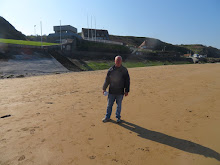
As you can see, history predominates, and I was on a Custer kick last year, going out to Montana in July to see the site of Custer's last stand. Since I had to drive 900 miles each way from my sister's house in St. Paul for a three-hour ramble around the remote battlefield, I boned up on Custerology before I went. (Right: Custer and his men perished on this incline in 1876 trying to reach the river in the background fringed by a line of green vegetation.)
I had always wanted to see that non-descript hillside leading down to the non-descript river where in 1876 desperate men fought for their lives, with the total annihilation of the 212 troopers under Custer's command being achieved in a mere ninety minutes at the onset of the battle. I think those troopers, relying on their superior firepower, roamed the slope above the great Indian encampment at will and kept the greatly more numerous Indian warriors at bay for the first sixty minutes; then the constant subversive incursions by warriors upon their skirmish lines caused the cavalrymen's tactical stability to start to erode, and suddenly some troopers started to flee and disintegration occurred and it was all over in a final, furious half hour of fight and flight. Four miles away on an isolated hilltop overlooking the river, most of the men under the combined command of Reno and Benteen survived a two-day besiegement. The archaeological book by Fox heading the list told a fascinating forensic tale about Custer's last battle.
Two of the books on the list were books that I reread. I read the Sandoz book about the Little Bighorn battle again after 35 years; indeed, this little gem of a history book, which exonerates Reno for responsibility for Custer's demise, is what fired up my desire in the first place to go visit this remote battlefield someday. The other reread on the list contains my favorite short story of all time, a haunting, bittersweet love story by J.D. Salinger called The Laughing Man. The summer I was a camp counselor in New Jersey at age 16 for economically deprived youths from the inner New York City, I read that story at nighttime to my tough 12 year-old charges and it held them mesmerized.
I don't read much fiction but I always enjoy Robert Louis Stevenson and Kidnapped was no exception, no matter how implausible its plot was. I like his highly complex sentence structures and gorgeous descriptions. I almost drowned in a rapids in 2010 and Stevenson's description of his hero's near drowning in a surf transported me back for a few mesmerizing moments to my own struggles underwater.
Besides the two Custer books already mentioned, four other books dealt with the Custer battle, one being a personal account of the combat by Windolph that included other interesting accounts about participants culled from contemporary letters, news stories and court martial testimony. The other three books just added to the mystery of the battle of annihilation and instilled in me an appreciation for the inevitability of that day's occurrence; once disaster starts to happen it is very difficult to counter, although this can lead to the emergence of heroes.
Wambaugh's book was a gripping tale about a serial arsonist, and Ambrose's book about the Screaming Eagles fighting from Normandy to Berchtesgaden is a legendary Greatest Generation account. I thought the account of Hannibal, one of history's great captains, moving his army from Spain to Italy through the Alps (with his elephants) was an interesting exposition on the value of surprise in war and the benefits that can go to someone who thinks outside the box.
Vonnegut's book Canary in a Cat House was a hardback I bought recently on Amazon; I had tried to find it all through the seventies when I was attempting to read every single book that Vonnegut ever wrote. It was always listed in his books as a prior publication but was always unavailable. It turns out that this title contains all the same stories as those in another short story anthology of his, Welcome to the Monkey House, with one story added that was in yet another anthology of his anyway; but finding it at last gave me an opportunity to reread several of Vonnegut's older short stories, much to my enjoyment.
So what books did you read over the summer?

2 comments:
I have been reading A Short History of Nearly Everything by Bill Bryson for like a year now. So pathetic! I finally finished it - it is interesting, but slow.
there are a few books I tell myself I'll read again. I read them before I had the mental maturity to understand them, but I never get around them. I have wanted to reread your near death experience and I never have either.
I wish I could have the dedication you have to read that many books.
Happy New Year
Post a Comment